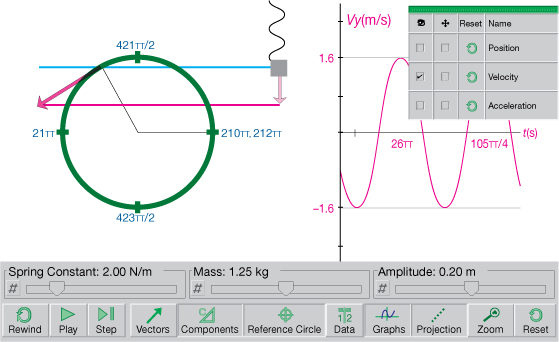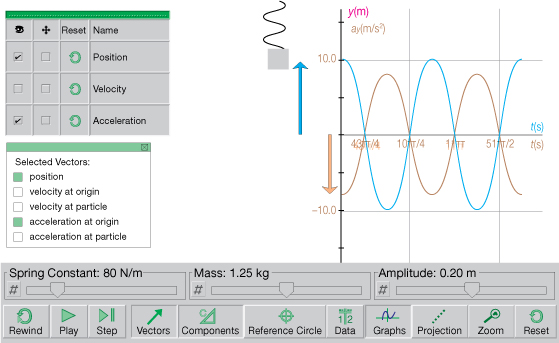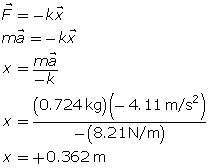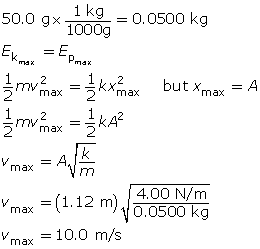Module 7—Oscillatory Motion
Simple Harmonic Motion Is Sinusoidal
Is simple harmonic motion an application of circular motion? If so, how are they related? Examining the velocity, acceleration, and position of a weighted spring as it oscillates will reveal any relationships. Tracking the velocity of the weighted spring as it vibrates through several cycles produces a curve that has precisely the same shape as a sinusoidal curve, so-called because it is like the graph of the sine function in trigonometry. That is, simple harmonic motion is sinusoidal in nature.
Simple harmonic motion is also based on uniform circular motion. Note that the x-axis on the illustration shows radian units. Why is this? The circumference of a circle is equal
to ![]() radians; and for each cycle of the weighted spring, it completes one circle.
radians; and for each cycle of the weighted spring, it completes one circle.

If you would like to know more about radian measure than just ![]()
![]() click Applied Mathematics 30 – Cyclic Patterns ; then click “Start” beside Graphing Cyclic Data. (You may need to obtain a username and a password from your teacher.)
click Applied Mathematics 30 – Cyclic Patterns ; then click “Start” beside Graphing Cyclic Data. (You may need to obtain a username and a password from your teacher.)
Reopen the Simple Harmonic Motion: Weighted Spring simulation, if necessary, and observe uniform circular motion and simple harmonic motion at the same time by doing the following:
- Reset the applet (
 ).
).
- Display the reference circle (
 ), vector components (
), vector components ( ), and projection lines (
), and projection lines ( ).
).
- Press the “Vectors” button (
 ), and select “velocity at particle” from the popup menu. You may have to drag the green bar from the popup to the upper right of the window so you can see the full popup and the full circle.
), and select “velocity at particle” from the popup menu. You may have to drag the green bar from the popup to the upper right of the window so you can see the full popup and the full circle.
- Press “Play.”
 Self-Check
Self-Check
SC 8. Describe one similarity and one difference between the velocity vector on the reference circle and the velocity vector on the weighted spring.
 Self-Check Answers
Self-Check Answers
SC 8. The velocity vectors are similar in their vertical magnitude. They are different in that the reference circle has both vertical and horizontal velocity while the weighted spring only exhibits vertical velocity.
Without changing any of the settings in the simulation, turn on the graphing function (![]() ), and select “Velocity,” as illustrated below. Then close vectors popup by clicking on the “Close” button. Close the graphing popup by pressing the “Graphs” button (
), and select “Velocity,” as illustrated below. Then close vectors popup by clicking on the “Close” button. Close the graphing popup by pressing the “Graphs” button (![]() ).
).

Review the questions below so you know what to look for, and click “Play.”
 Module 7: Lesson 1 Assignment
Module 7: Lesson 1 Assignment
Remember to submit the answer to TR 2 to your teacher as part of your Module 7: Lesson 1 Assignment.
 Try This
Try This
TR 2.
- How many rotations does the reference circle make for every complete wave (
 ) drawn on the graph?
) drawn on the graph?
- How many complete cycles does this represent on the weighted spring? Does this mean that the period for the circular motion is identical to the period of the simple harmonic motion?
- Compare the radius of the circle with the amplitude of the oscillator. How are they similar?
Set up the simulation as indicated in the following diagram by clicking the “Vectors” button (![]() ) popup. Choose the “position” and “acceleration at origin” selections; then click the “Vectors” button to close the popup. Next, click the graphing function (
) popup. Choose the “position” and “acceleration at origin” selections; then click the “Vectors” button to close the popup. Next, click the graphing function (![]() ), and select the “Position” and “Acceleration” functions, as illustrated below. Then click the “Graphs” button to close the popup.
), and select the “Position” and “Acceleration” functions, as illustrated below. Then click the “Graphs” button to close the popup.

Press “Play,” and observe the orientation of the acceleration and displacement vectors.
 Self-Check
Self-Check
SC 9. Explain how the orientation of the acceleration and displacement is related to the negative sign in ![]()
 Self-Check Answers
Self-Check Answers
SC 9. The acceleration and displacement are always pointing in opposite directions, so the force and displacement are also in opposite directions. The opposite directions are indicated mathematically using the negative in ![]()
![]()
 Read
Read
How can you calculate the maximum speed of a mass on a spring, and where does the maximum occur? Read pages 366 to 372 in your textbook to find out.
 Self-Check
Self-Check
SC 10. Complete question 1 of “Practice Problems” on page 372 of the textbook.
SC 11. Complete question 2 of “Practice Problems” on page 372 of the textbook.
 Self-Check Answers
Self-Check Answers
SC 10.
Given
m = 0.724 kg
k = 8.21 N/m
![]()
Required
the displacement of the mass at that acceleration (x)
Analysis and Solution
Choose the positive direction to be to the right. Then the acceleration will have a negative value. Use Hooke’s law and Newton’s second law to find the displacement.

Paraphrase
The displacement of the mass is 0.362 m [right].
SC 11.
Given
m = 50.0 g
k = 4.00 N/m
A = 1.12 m
Required
the maximum speed of the mass
Analysis and Solution
Convert the mass to kilograms. The maximum speed can be found from the maximum kinetic energy. The maximum kinetic energy will equal the maximum potential energy, which occurs at the maximum displacement, the amplitude.

Paraphrase
The maximum speed of the mass is 10.0 m/s.
 Module 7: Lesson 1 Assignment
Module 7: Lesson 1 Assignment
Remember to submit the answer to TR 3 to your teacher as part of your Module 7: Lesson 1 Assignment.
TR 3.
-
A 250-g object hangs from a spring and oscillates with an amplitude of 5.42 cm. If the spring constant is 48.0 N/m, determine the acceleration of the object when the displacement is 4.27 cm [down].
-
If the spring constant is 48.0 N/m, determine the maximum speed. Tell where the maximum speed will occur.